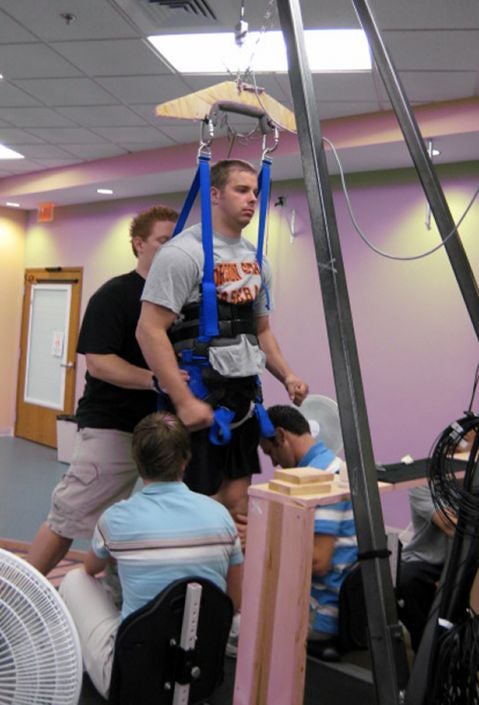Your support helps us to tell the story
From reproductive rights to climate change to Big Tech, The Independent is on the ground when the story is developing. Whether it's investigating the financials of Elon Musk's pro-Trump PAC or producing our latest documentary, 'The A Word', which shines a light on the American women fighting for reproductive rights, we know how important it is to parse out the facts from the messaging.
At such a critical moment in US history, we need reporters on the ground. Your donation allows us to keep sending journalists to speak to both sides of the story.
The Independent is trusted by Americans across the entire political spectrum. And unlike many other quality news outlets, we choose not to lock Americans out of our reporting and analysis with paywalls. We believe quality journalism should be available to everyone, paid for by those who can afford it.
Your support makes all the difference.A hit-and-run victim who was completely paralysed from the waist down has stood up on his own and taken faltering steps on a treadmill after pioneering treatment.
American Rob Summers, 25, is the first patient to respond to the groundbreaking therapy, which involves many hours of training combined with electrical stimulus.
He said: "This procedure has completely changed my life."
The treatment, which took 30 years to develop, by-passes the brain and "teaches" the spinal cord to control limbs and body functions independently.
As a result, Mr Summers, who is normally confined to a wheelchair, has been able to push himself up and stand for several minutes without assistance.
With help, he has also made repeated stepping motions on a treadmill and voluntarily moved his hips, knees, ankles and toes. In addition, he has regained some sexual and bladder function.
Scientists described the success, reported in The Lancet medical journal, as "a breakthrough" but cautioned that there was still much more work to be done.
Mr Summers was walking by a road in Portland, Oregon, USA, when a car mounted the kerb and smashed into him on July 12 2006.
Previously an athlete in peak physical condition, he suffered serious spinal cord damage which left him paraplegic.
Five patients in total are taking part in the trial which follows promising results with animals.
A key element of the treatment involves stimulating nerves with a 16-electrode implant inserted into the spinal cord.
The signals mimic those which would normally be transmitted by the brain.
An intensive regime of movement training, delivered with the help of rehabilitation specialists, comprises the other half of the therapy.
Sensory inputs from the legs combined with the electrical stimulation help the spine's own neural network to reactivate muscles and joints.
Professor Reggie Edgerton, from the University of California at Los Angeles, a leading member of the 11-person team of researchers, said: "The spinal cord is smart. The neural networks in the lumbosacral spinal cord are capable of initiating full weight bearing and relatively co-ordinated stepping without any input from the brain. This is possible, in part, due to information that is sent back from the legs directly to the spinal cord.
"This sensory feedback from the feet and legs to the spinal cord facilitates the individual's potential to balance and step over a range of speeds, directions and level of weight bearing.
"The spinal cord can independently interpret these data and send movement instructions back to the legs - all without cortical (brain) involvement."
Colleague Professor Susan Harkema, from the Kentucky Spinal Cord Research Centre at the University of Louisville, said: "This is a breakthrough. It opens up a huge opportunity to improve the daily functioning of these individuals, but we have a long road ahead."
Mr Summers described what it meant to him to gain even inches of ground in his battle with paralysis.
He said: "For someone who for four years was unable to even move a toe, to have the freedom and ability to stand on my own is the most amazing feeling.
"To be able to pick up my foot and step down again was unbelievable, but beyond all of that my sense of well-being has changed. My physique and muscle tone has improved greatly, so much that most people don't even believe I am paralysed. I believe that epidural stimulation will get me out of this chair."
The scientists hope that in future some severely paralysed patients at least will be able to recover enough independent movement to stand, maintain balance and even begin to walk.
However, they acknowledge that the technique is still far from being a practical treatment.
One unanswered question is whether it can help patients even more severely handicapped than Mr Summers. Although completely paralysed below the chest, he retained some level of feeling below the site of his injury. It is also not known whether his high level of fitness before the accident made a difference.
The research was supported by the Christopher & Dana Reeve Foundation, the charitable organisation founded by the late Superman actor Christopher Reeve and his wife.
Mr Reeve, who died in 2004, was paralysed from the neck down in a horse riding accident in 1995, after which he campaigned tirelessly on behalf of spinal injury research.
Susan Howley, executive vice president for research at the foundation, said: "It's an exciting development. Where it leads to from here is fundamentally a matter of time and money."

Join our commenting forum
Join thought-provoking conversations, follow other Independent readers and see their replies
Comments